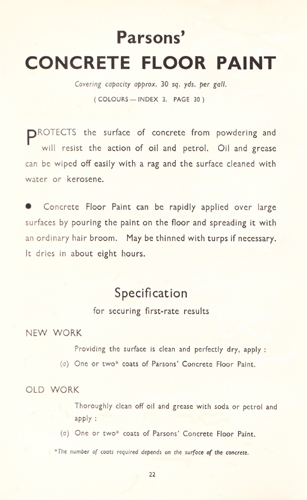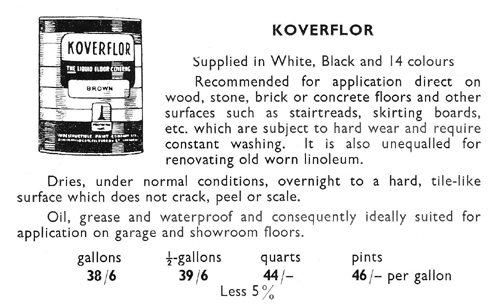A previous post has already introduced the subject of a most useful work that was published in the 1930s – Parsons’ Decorative Finishes. Subsequently I have used it as a ‘prompt’ for posts dealing with Imitation Stone Paints, Permanent Greens, Gloss Enamels, Gloss Finishes and Antimonic paints.

The book is divided into 17 sections and it is the first three of these that will be considered in this post, which looks at a semi-gloss finish offered by Thomas Parsons’ at the time. Some of the other finishes were classed as enamels and these have been discussed in an earlier post. Others, called hard-gloss finishes, were covered in another post.
Section One
The first section of Parsons’ Decorative Finishes is headed Bill of Quantities and gives the framework for anyone wishing to specify the paints contained in the book.
Section Two
Explains where each of the Parsons’ finishes was best used and provides a Specification for New and Old Work.

Section Three
This consisted of a colour card, which is shown above.
Concrete Floor Paints
Painted floors have certain advantages compared with separate floor coverings. They are comparatively cheap, can be renovated or renewed cheaply and are easily cleaned. Conventional oil paint at this time was not suitable because, being largely composed of linseed oil, it took too long to harden sufficiently to walk on. Even if sparingly applied, a linseed oil film is apt to tear up, not helped by the tendency of the painter is to apply paint more heavily on a horizontal surface than a vertical one.
Concrete floors were best painted, not only to prevent the surface from ‘dusting’, but also to protect against oil or petrol, which could be wiped off readily. Paint provided an inexpensive means of decoration. However, the floor had to be bone dry first, although with recent developments in synthetic resins and the introduction of tung oil, which is tough and waterproof, it was no longer essential to wait for a year or so for the concrete to mature. Care must be taken that moisture is not bottled up, or flaking will occur. The nature of concrete floors is such that they offer a firm grip for paint, and enable a good surface to be produced.
Concrete is highly-alkaline and a careful selection of colour was advisable when painting it. Such pigments as Prussian blue, the Brunswick greens, and lead chromes will prove far from satisfactory. Brunswick greens separate out, the chrome yellow becoming first dirty then reddish-brown, while Prussian blue reverts to the colour of iron rust.* If greens must be used it should be of an earthy base. Naturally low in tone, there are greens that when supplemented by aniline dyes are good in colour and stable – one such is shown above. Several of the other colours shown here were largely tined with iron oxide pigments. Floor paints were generally heavily pigmented as this facilitated uniform wear. Painting concrete too soon with an oil paint would result not only in the loss of colour, but it would saponify the oil content i.e. convert it into soap and separate from the pigment. On a vertical wall this gives the appearance of tears.
Concrete paints were similar in character to the Quick-Drying Enamels (see the section on ‘Half-Time’ Enamels in an earlier post) but were made from shorter oil length varnishes and usually contained hard pigments such as silica and slate powder.
At this time Parson’s Concrete Paint would have produced a hard-wearing, quick drying semi-gloss finish. It would have dried, tack free, in 8-12 hours, but should have been left at least two days before walking on.

Nowadays floor paints tend to be either highly-pigmented paints in a hard varnish medium, resistant to chipping or are based on epoxy resins and supplied either as one-pack or two-pack materials. Other types are produced especially for garages, where it was found that the combination of oil and car tyres would be detrimental to the surface. Floor paints are also now available for harsh conditions of outdoor exposure and which contain anti-slip ingredients. These can be used for the decks of ocean-going vessels and for the gantries and walkways of industrial premises.
*It is interesting to note that Brunswick green tends to be unstable on exterior surfaces as can be seen in this blog post.
1930s Paint Colours
Should anyone want to use any of the paint colours shown on these colour cards Papers and Paints will be able to match them in most conventional finishes.
View Larger Map













No comments yet. Be the first!